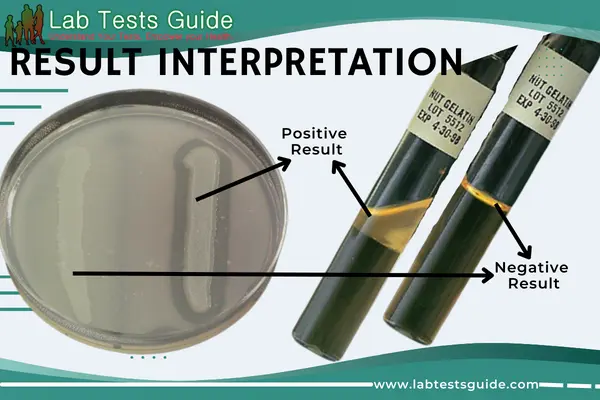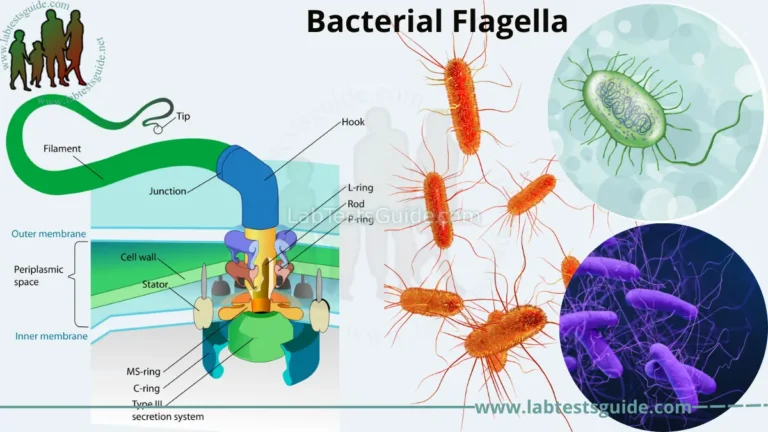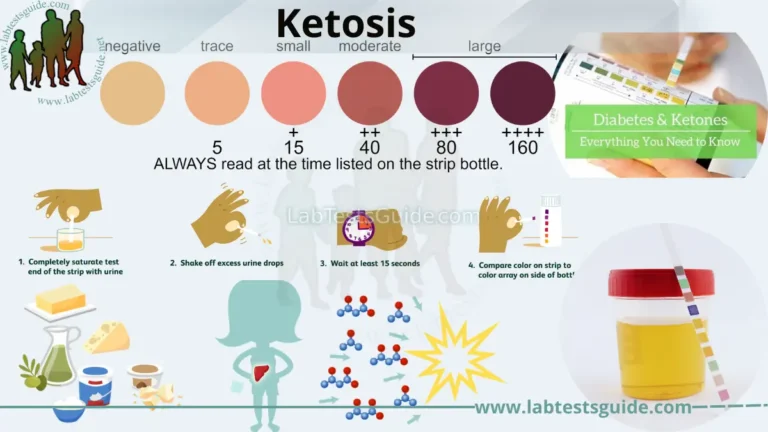The Gelatin Hydrolysis Test is a microbiological test used to determine the ability of certain bacteria to produce the enzyme gelatinase, which is capable of breaking down gelatin. The test is performed by adding a sample of the bacterium to a gelatin medium, and then observing for the formation of a clear zone around the bacterial growth, indicating the production of gelatinase and the degradation of the gelatin. The results of the test can be used to identify and classify different types of bacteria based on their gelatinase production.
Gelatin hydrolysis test is a biochemical test performed as a presumptive test for the identification of Staphylococcus, Enterococcus, and other Gram-positive bacilli.

Purpose of Gelatin Hydrolysis Test:
Here are some of the key purposes of the Gelatin Hydrolysis test:
- Identification and characterization of bacterial species: The Gelatin Hydrolysis test can be used to aid in the identification and characterization of bacterial species based on their ability to produce the enzyme gelatinase and to hydrolyze gelatin.
- Differentiation of bacterial species: The Gelatin Hydrolysis test can help to differentiate between bacterial species based on their ability to produce gelatinase and to hydrolyze gelatin. This information can be useful for clinical and diagnostic purposes.
- Detection of gelatinase-producing bacteria: The Gelatin Hydrolysis test can be used to detect bacteria that produce the enzyme gelatinase and have the ability to hydrolyze gelatin.
- Quality control of bacterial cultures: The Gelatin Hydrolysis test can be used as a quality control test to verify the purity of bacterial cultures and to eliminate contamination by other bacteria.
- Study of bacterial physiology: The Gelatin Hydrolysis test can be used to study the physiology of bacteria and to understand their metabolic pathways and mechanisms of growth.
- Research and development: The Gelatin Hydrolysis test can be used in research and development to study the properties and characteristics of bacterial species, to identify new bacterial strains, and to develop new diagnostic and therapeutic strategies.
Objectives of Gelatin Hydrolysis Test
The objective of the Gelatin Hydrolysis test is to determine the ability of bacteria to produce the enzyme gelatinase, which hydrolyzes the protein gelatin. This test is used to differentiate between different bacterial species and to classify them based on their gelatin hydrolysis ability. This information can be used in medical and industrial settings to identify and classify bacteria, and to determine the best course of action for treating bacterial infections or controlling bacterial contamination.
Principle of Gelatin Hydrolysis Test
The principle of the Gelatin Hydrolysis test is based on the ability of bacteria to produce the enzyme gelatinase, which hydrolyzes the protein gelatin. The steps of the test are as follows:
- Preparation of Gelatin: Gelatin is dissolved in sterile water and sterilized by autoclaving to produce a clear, homogeneous solution.
- Inoculation of Gelatin: The sterilized gelatin solution is inoculated with a bacterial suspension or culture.
- Incubation: The inoculated gelatin solution is incubated at an appropriate temperature and time to allow bacterial growth and gelatin hydrolysis.
- Observation: After incubation, the appearance of the gelatin solution is observed for any signs of liquefaction or clearing, which indicate the presence of gelatinase and the ability of the bacteria to hydrolyze gelatin.
- Interpretation of Results: Based on the appearance of the gelatin solution, the results can be interpreted as positive or negative for gelatin hydrolysis. A positive result (liquefaction or clearing of the gelatin solution) indicates the presence of gelatinase and the ability of the bacteria to hydrolyze gelatin. A negative result (no change in the appearance of the gelatin solution) indicates the absence of gelatinase and the inability of the bacteria to hydrolyze gelatin.
Microorganisms Tested
In the Gelatin Hydrolysis test, a wide range of microorganisms can be tested, including bacteria, fungi, and yeast. The test is commonly used to identify and classify bacterial species, including:
- Staphylococcus aureus
- Clostridium perfringens
- Proteus vulgaris
- Pseudomonas aeruginosa
- Bacillus subtilis
This test can also be used to differentiate between different strains of bacteria within a species. In medical and industrial settings, the Gelatin Hydrolysis test is used as part of a battery of tests to identify and classify bacteria for purposes of disease diagnosis, treatment, and control of bacterial contamination.
Medias:
The Gelatin Hydrolysis test is usually performed using the following media:
- Nutrient Agar: This is a general-purpose, non-selective medium that supports the growth of a wide range of microorganisms.
- Gelatin Agar: This is a specialized medium that contains gelatin as the sole source of protein.
- Tryptic Soy Agar: This is a general-purpose medium that contains soy protein as a source of nitrogen. It is often used as a control in the Gelatin Hydrolysis test to assess the growth of bacteria without the presence of gelatin.
The choice of medium used in the Gelatin Hydrolysis test depends on the specific goals and objectives of the test, as well as the type of microorganisms being tested. The media used must be sterilized by autoclaving to ensure that no contaminants are present that could interfere with the test results.
Nutrient Gelatin Media
Nutrient Gelatin media is a type of growth medium used in the Gelatin Hydrolysis test. It is a combination of Nutrient Agar and Gelatin Agar, and provides a source of nutrients and energy for bacterial growth, as well as a source of protein in the form of gelatin. The composition of Nutrient Gelatin media typically includes:
- Peptones: Typically, peptones from animal or plant sources are used as a source of nitrogen and carbon for bacterial growth.
- Beef extract: This is a source of vitamins, minerals, and other essential nutrients for bacterial growth.
- Gelatin: This is a source of protein that is hydrolyzed by bacteria producing the enzyme gelatinase.
- Manganese sulfate: This is used to regulate the osmotic balance of the medium.
- Agar: This is used as a solidifying agent to provide structure to the medium.
| Ingredients | Gram/liter |
| Peptones (Tryptose) | 20.0 |
| Beef extract | 3.0 |
| Gelatin | 10.0 |
| Manganese sulfate | 0.01 |
| Agar | 15.0 |
The Nutrient Gelatin medium is sterilized by autoclaving and then inoculated with a bacterial culture or suspension. After incubation, the appearance of the medium is observed to determine if the bacteria have hydrolyzed the gelatin, which is indicated by the formation of a clear zone or the liquefaction of the gel. The Nutrient Gelatin medium provides a convenient and reliable way to perform the Gelatin Hydrolysis test and to assess the ability of bacteria to produce gelatinase.
Reagents and Supplies :
Reagents and supplies used for Nutrient Gelatin Media
The following reagents and supplies are typically used for the preparation of Nutrient Gelatin media:
- Peptones: These can be animal- or plant-derived and serve as a source of nitrogen and carbon for bacterial growth.
- Meat extract: This is a source of vitamins, minerals, and other essential nutrients for bacterial growth.
- Gelatin: This is the protein that is hydrolyzed by bacteria producing the enzyme gelatinase.
- Manganese sulfate: This is used to regulate the osmotic balance of the medium.
- Agar: This is used as a solidifying agent to provide structure to the medium.
- Distilled water: This is used to dissolve the ingredients and make up the volume of the medium.
- Autoclave: This is used to sterilize the medium by subjecting it to high heat and pressure.
- Glass or plastic containers: These are used to store and transport the medium.
- Inoculating loop or needle: This is used to transfer the bacterial culture or suspension to the medium.
- Incubator: This is used to incubate the medium at an appropriate temperature to allow bacterial growth.
- Sterile test tubes or Petri dishes: These are used to prepare and store the medium.
In addition to these reagents and supplies, various other laboratory equipment and materials may be required depending on the specific goals and objectives of the experiment and the methods being used.
Method:
There are several methods for determining gelatinase production, all of which make use of gelatin as the substrate. The standard and most commonly employed method is the nutrient gelatin stab method.
Stab method
- Inoculate the gelatin deep with 4 to 5 drops of a 24-hour broth culture.
- Incubate at 35°-37°C in ambient air for up to 14 days.
Note: Incubate the medium at 25°C if the organism grows better at 25°C than at 35°C. - Alternatively, inoculate the gelatin deep from a 24-hour-old colony by stabbing four or five times, 0.5 inch into the medium.
- Remove the gelatin tube daily from the incubator and place at 4°C to check for liquefaction.
Note: Do not invert or tip the tube, because sometimes the only discernible liquefaction occurs at the top of the deep where inoculation occurred. - Refrigerate an un-inoculated control along with the inoculated tube. Liquefaction is determined only after the control has hardened (gelled).
Plate method
- Stab-inoculate a heavy inoculum of an 18- to 24-hour-old test bacteria onto culture plates prefilled with nutrient gelatin (23 g/liter nutrient agar, 8 g/liter gelatin).
- Incubate inoculated nutrient gelatin plates at 35oC for 24 hours
Note: In some cases, plates are flooded with saturated ammonium sulfate to precipitate unhydrolyzed gelatin, making the clear zones easier to see. Results are often observed within 5 to 10 minutes after flooding with saturated ammonium sulfate.
Result Interpretation
The results of the Gelatin Hydrolysis test are interpreted based on the appearance of the Nutrient Gelatin medium after incubation. The following are the two possible outcomes and their interpretations:
- Positive Result: If the bacteria being tested produce the enzyme gelatinase, they will hydrolyze the protein gelatin, causing the medium to become liquefied or to form a clear zone. This indicates that the bacteria are capable of producing gelatinase and that they have the ability to hydrolyze the protein gelatin.
- Negative Result: If the bacteria do not produce the enzyme gelatinase, the Nutrient Gelatin medium will remain solid and unchanged. This indicates that the bacteria do not have the ability to produce gelatinase and that they are unable to hydrolyze the protein gelatin.

| Species | Growth | Liquefaction |
| Bacillus subtilis | + | + |
| Clostridium perfringens | + | + |
| Escherichia coli | + | – |
| Proteus vulgaris | + | + |
| Serratia liquefaciens | + | + |
| Staphylococcus aureus | + | + |
It is important to note that not all bacteria are capable of producing gelatinase and that the Gelatin Hydrolysis test is not a definitive test for the identification of bacteria. However, it can provide valuable information about the ability of bacteria to produce gelatinase and can be used in combination with other tests to aid in the identification and characterization of bacterial species.
Control Organisms
Control organisms are bacteria used in the Gelatin Hydrolysis test to provide a reference point for the interpretation of results. There are two types of control organisms commonly used in this test:
- Positive Control: A positive control is a known bacterium that is capable of producing the enzyme gelatinase and should produce a positive result in the Gelatin Hydrolysis test. The purpose of using a positive control is to confirm that the test is working properly and to demonstrate the expected outcome when bacteria are able to produce gelatinase.
Example: Bacillus subtilis. - Negative Control: A negative control is a known bacterium that does not produce the enzyme gelatinase and should produce a negative result in the Gelatin Hydrolysis test. The purpose of using a negative control is to confirm that the test is working properly and to demonstrate the expected outcome when bacteria are unable to produce gelatinase.
Example: Escherichia coli
Using control organisms helps to ensure that the results of the Gelatin Hydrolysis test are accurate and to minimize the risk of false positive or false negative results. The specific control organisms used in the test may vary depending on the goals and methods being used, but the use of both a positive and negative control is generally recommended.
Positive Organisms:
The following are some examples of bacteria that are commonly used as positive controls in the Gelatin Hydrolysis test:
- Clostridium perfringens
- Bacillus licheniformis
- Proteus vulgaris
- Streptococcus pyogenes
- Staphylococcus aureus
These bacteria are known to produce the enzyme gelatinase and should produce a positive result in the Gelatin Hydrolysis test, indicating that they have the ability to hydrolyze the protein gelatin. The specific positive control organisms used in the test may vary depending on the goals and methods being used and the species of bacteria being tested.
Negative Organisms:
The following are some examples of bacteria that are commonly used as negative controls in the Gelatin Hydrolysis test:
- Escherichia coli
- Klebsiella pneumoniae
- Salmonella typhi
- Shigella dysenteriae
- Pseudomonas aeruginosa
These bacteria do not produce the enzyme gelatinase and should produce a negative result in the Gelatin Hydrolysis test, indicating that they are unable to hydrolyze the protein gelatin. The specific negative control organisms used in the test may vary depending on the goals and methods being used and the species of bacteria being tested. The use of negative control organisms helps to ensure that the results of the Gelatin Hydrolysis test are accurate and to minimize the risk of false positive results.
Limitations :
Here are some of the key limitations of the Gelatin Hydrolysis test:
- False negatives: Some bacteria may not produce sufficient amounts of gelatinase to cause significant hydrolysis of gelatin, resulting in a false negative result in the Gelatin Hydrolysis test.
- False positives: Some bacteria may produce proteases that are able to degrade gelatin, resulting in a false positive result in the Gelatin Hydrolysis test.
- Incomplete hydrolysis: Some bacteria may produce gelatinase but only partially hydrolyze gelatin, leading to an inconclusive result in the Gelatin Hydrolysis test.
- Interference from other factors: Other factors such as the pH, temperature, and composition of the growth medium may interfere with the Gelatin Hydrolysis test, leading to inaccurate results.
- Limited specificity: The Gelatin Hydrolysis test is not highly specific and may produce false results if the bacteria produce proteases other than gelatinase.
- Time-consuming: The Gelatin Hydrolysis test is time-consuming, requiring incubation of the bacteria and gelatin for several hours or overnight, which may not be practical for some applications.
- Equipment and reagents: The Gelatin Hydrolysis test requires specialized equipment and reagents, which may not be readily available or accessible in some laboratories.
FAQs:
What is the Gelatin Hydrolysis test used for?
The Gelatin Hydrolysis test is used to determine if bacteria are capable of producing the enzyme gelatinase and to evaluate their ability to hydrolyze the protein gelatin. This information can be used to aid in the identification and characterization of bacterial species.
How is the Gelatin Hydrolysis test performed?
The Gelatin Hydrolysis test is performed by adding a bacterial culture to Nutrient Gelatin medium, incubating the mixture, and then observing the appearance of the medium. If the bacteria produce the enzyme gelatinase, they will hydrolyze the protein gelatin, causing the medium to become liquefied or to form a clear zone. If the bacteria do not produce the enzyme gelatinase, the Nutrient Gelatin medium will remain solid and unchanged.
What is the interpretation of results in the Gelatin Hydrolysis test?
A positive result in the Gelatin Hydrolysis test indicates that the bacteria are capable of producing gelatinase and that they have the ability to hydrolyze the protein gelatin. A negative result indicates that the bacteria do not have the ability to produce gelatinase and are unable to hydrolyze the protein gelatin.
What are control organisms and why are they used in the Gelatin Hydrolysis test?
Control organisms are bacteria used in the Gelatin Hydrolysis test to provide a reference point for the interpretation of results. A positive control is a known bacterium that is capable of producing the enzyme gelatinase and should produce a positive result in the test. A negative control is a known bacterium that does not produce the enzyme gelatinase and should produce a negative result in the test. Using control organisms helps to ensure that the results of the Gelatin Hydrolysis test are accurate and to minimize the risk of false positive or false negative results.
Are there any limitations of the Gelatin Hydrolysis test?
Yes, there are limitations of the Gelatin Hydrolysis test. Not all bacteria are capable of producing gelatinase and the Gelatin Hydrolysis test is not a definitive test for the identification of bacteria. It should be used in combination with other tests to aid in the identification and characterization of bacterial species. Additionally, false positive or false negative results may occur if the test is not performed or interpreted correctly.
Referances:
- Bailey & Scott’s Diagnostic Microbiology, Forbes, 11th edition
- Koneman’s Color Atlas and Textbook of Diagnostic Microbiology
- Clinical Microbiology Procedures Handbook, Fourth Edition. (2016). In Clinical Microbiology Procedures Handbook, Fourth Edition. American Society of Microbiology. https://doi.org/10.1128/9781555818814
- Nutrient Gelatin. M060. HiMedia Laboratories.
- Biochemical Tests for the Identification of Aerobic Bacteria. (2016). Clinical Microbiology Procedures Handbook, 3.17.1.1–3.17.48.3.
- Thomas Edison E. dela Cruz, Jeremy Martin O. Torres. 2012. Gelatin hydrolysis test protocol.
- Joseph J. McDade, R. H. Weaver. RAPID METHODS FOR THE DETECTION OF GELATIN HYDROLYSIS. Journal of Bacteriology. Jan 1959, 77 (1) 60-64.
- https://microbeonline.com/gelatin-hydrolysis-test-principle-procedure-expected-results/
- http://www.himedialabs.com/TD/M060.pdf
- https://www.thomassci.com/Laboratory-Supplies/Microbiological-Media/_/Nutrient-Gelatin1
- https://sfamjournals.onlinelibrary.wiley.com/doi/epdf/10.1111/jam.12840
- https://www.sciencedirect.com/topics/chemistry/gelatin
- https://www.ncbi.nlm.nih.gov/pmc/articles/PMC3426542/
- https://microbiologynotes.com/gelatin-hydrolysis-test-principle-uses-media-procedure-and-result/
- https://microbenotes.com/gelatin-hydrolysis-test-principle-procedure-and-result-interpretation/
- http://www.uwyo.edu/molb2210_lab/info/biochemical_tests.htm
- https://quizlet.com/134986028/microbiology-lab-exam-3-flash-cards/
- https://jb.asm.org/content/jb/8/4/297.full.pdf
- https://en.wikipedia.org/wiki/Microbiological_culture
Possible References Used







